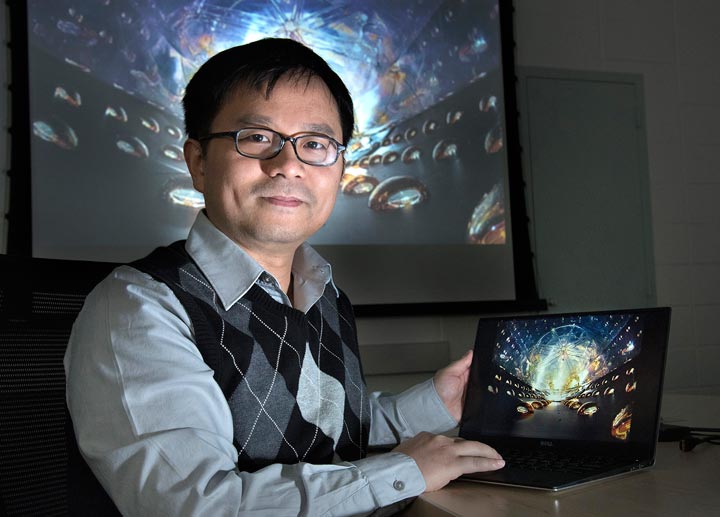Brookhaven Lab's Role in the Analysis of Reactor Antineutrino Energy Spectrum and Flux
February 12, 2016
 enlarge
enlarge
Brookhaven physicist Chao Zhang, a member of the Daya Bay collaboration, with an image showing photomultiplier tubes inside one of the Daya Bay detectors.
The U.S. Department of Energy’s (DOE) Brookhaven National Laboratory plays multiple roles in the Daya Bay Collaboration, ranging from project management to data analysis. In addition to coordinating detector engineering and design efforts and developing software and analysis techniques, Brookhaven scientists perfected the "recipe" for a very special, chemically stable liquid that fills Daya Bay's detectors and interacts with antineutrinos.
Brookhaven scientists also led the core analysis group that contributed to the measurements of reactor antineutrino energy spectrum and flux reported in this press release.
“We were the first to notice the surprising feature in the energy spectrum, only a few months after the first experimental hall started taking data in 2011,” said Brookhaven physicist Chao Zhang, a member of the team.
The Brookhaven physicists developed the methods to calibrate the detector energy response, which were crucial for this precision measurement, and studied the subtle systematic effects that could impact the measurement and the interpretation of the results.
"We spent a lot of time and effort to fully understand our detector energy response,” Chao said. “In the end, this has all paid off and we now have the world's most precise measurement of the reactor antineutrino energy spectrum—a model-independent reference spectrum that future reactor experiments can safely rely on."
These experiments with reactor neutrinos have played a critical role in scientists’ understanding of their cosmic cousins—the abundant neutrinos generated by the Big Bang and in the hearts of stars.
"The surprising feature in the reactor antineutrino energy spectrum indicates that there is still so much we need to understand about the underlying nuclear physics," Chao said.
Brookhaven National Laboratory’s participation in the Daya Bay Collaboration is funded by the DOE Office of Science.
Brookhaven National Laboratory is supported by the Office of Science of the U.S. Department of Energy. The Office of Science is the single largest supporter of basic research in the physical sciences in the United States, and is working to address some of the most pressing challenges of our time. For more information, please visit science.energy.gov.
2016-6161 | INT/EXT | Newsroom









